35th International Conference on Boundary Elements and Other Mesh Reduction Methods
New Forest, UK
Overview
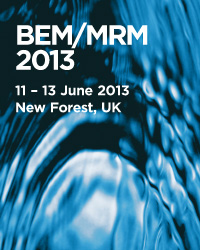
The 35th International Conference on Boundary Elements and Other Mesh Reduction Methods recently took place in the New Forest, home of the Wessex Institute of Technology. The meeting was chaired by Prof Carlos A Brebbia, Director of that Institute, and Prof Alex Cheng from University of Mississippi at Oxford, USA.
The Conference is the recognised international forum for the presentation and discussion of the latest developments of these methods and their applications in science and engineering.
The continuous success of the conference since the first meeting took place in 1978 indicates the strength of the work carried out by different groups around the world. The history of the conference traces the evolution of the methods since BEM grew from classical boundary integral techniques up to more versatile and recent Mesh Reduction Methods.
The Conference has produced a series of volumes in which all major developments in the field have been reported. This valuable collection has been available in digital form since 1993 when the volumes started to be archived in the eLibrary of Wessex Institute (http://library.witpress.com/) where they can be easily accessible by the International Scientific Community.
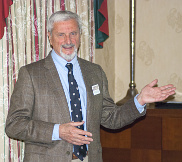
Carlos referred to the importance of the facilities at WIT Campus and the search for quality and strengthening links across the world.
Major areas of expansion at Ashurst Lodge are the continuous increase in the number of publications, including not only conference proceedings, but a substantial number of books and monographs. Carlos also pointed out that WIT Press, the publishing arm of the Institute, has already launched four International Journals, which aim to become open access to promote the rapid dissemination of research within the industrial, academic and professional communities.
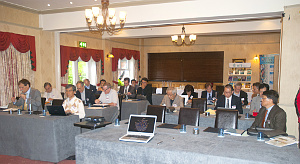
Carlos finished by thanking the delegates for having come to the New Forest to participate in the conference and hoping that they will enjoy their visit to the Wessex Institute of Technology.
Keynote Address
The keynote address was given by Alex Cheng on the topic of ‘Trend of BEM and other mesh reduction and meshless methods’. He referred to the development of the method dealing with:
-
Hybrid Variation and Formulations
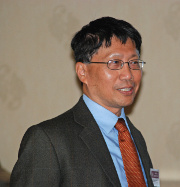 Prof. Cheng
Prof. Cheng - Symmetric Galerkin Methods
- Mesh free BEM
- MFS and Trefftz method
- Efficient Volume Integration
- Fast Solutions
- Isogeometic BEM
- ‘Intelligent Robot’ methodology and applications
The future, Alex said, is to be able to reach industry.
There are different tools to convert the solution to the boundary:
- Dual Reciprocity Method
- Multiple Reciprocity Method
Alex referred to different types of mesh reduction methods describing their advantages and disadvantages. He also referred to the shortcomings of finite elements versus some of the advantages of BEM. Alex Cheng’s presentation was followed by a lively discussion.
Papers from the ISAC
Other interesting papers at the conference were presented by members of the International Scientific Advisory Committee, ie
- ‘Performance comparison of the local boundary integral equation (LBIE) and radial basis integral equation (RBIE) methods’ by Viktor Popov, Wessex Institute of Technology, UK
- ‘Numerical investigation of turbulent natural convection in enclosures’ by Leopold Skerget, University of Maribor, Slovenia
- ‘Three-dimensional Cauchy-condition surface method to reconstruct the last closed magnetic surface in non-axisymmetric fusion plasma’ by Masafumi Itagaki, University of Hokkaido, Japan
- ‘Meshless solution of laminar flow in a 2D backward-facing step’ by Eduardo Divo, Embry-Riddle Aeronautics University, USA
- ‘Pattern formation simulations in reaction-diffusion systems by Local Integral Equation Method’ by Vladimir Sladek, Slovak Academy of Science
- ‘Stability analysis for laminates with general anisotropy using boundary elements’ by Stavros Syngellakis, Wessex Institute of Technology, UK
- ‘Wire antenna model of the vertical grounding electrode’ by Dragan Poljak, University of Split, Croatia
- ‘Meshless analysis of soil-structure interaction using a MFS-MLPG coupled approach’ by Luis Godinho, University of Coimbra, Portugal
- ‘Laminar flame propagation modelling using the Radial Basis Function (RBF) method’ by Manuel Kindelan-Segura, University Carlos III, Spain
- ‘An alternative dynamic fundamental solution for plate bending including the shear deformation effect’ by Leandro Palermo, University of Campinas (Unicamp), Brazil
- ‘A GPU-accelerated meshless method for two-phase incompressible fluid flows’ by Alain Kassab, University of Central Florida, USA
- ‘Coupled multi-domain BEM and FEM for fluid-structure interaction analysis’ by Elena Strelnikova, Ukrainian Academy of Sciences, Ukraine
- ‘Assessment of the spectral properties of the double-layer potential matrix H’ by Ney Augusto Dumont, Catholic University of Rio de Janeiro, Brazil
- ‘BEM formulation based on dipoles of stresses applied to crack growth modelling in quasi-brittle materials’ by Edson Leonel, University of San Paulo, Brazil
EABE Meeting
The Annual General Meeting of the Editorial Board of the International Journal of Engineering Analysis in the Boundary Elements and other Mesh Reduction Methods (EABE) took place during the first evening of the meeting, presided by its Editor, Prof Alex Cheng and with the participation of a substantial number of the Board Members. The Journal continues to be very successful and the main publication for boundary element as well as mesh solution papers. Different issues were discussed relating to increasing the quality of the Journal and its dissemination throughout the world. An effort will be made to attract more papers from industry. Authors presenting papers at BEM35 were invited to submit extended versions of their work for publication in EABE.
Excursion
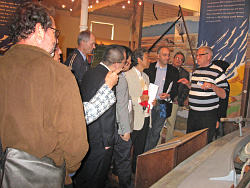
Lymington now has negligible trade as a port. However, it was for many years the most important of the New Forest ports. The church in Lymington is mainly famous for having been used as a stable by Cromwell’s soldiers. The town saw little fighting during the Civil War but there was constant movement of troops because of its harbour. The most beautiful part of Lymington is its wide main street and the numerous Georgian houses on either side. Its port is now small and mainly used by pleasure boats, but in 1345 it contributed more men and boats than Portsmouth to the fleet marshalled by England for the invasion of France.
At the bottom of the High Street is a lane descending to the port along Quay Hill, with beautiful cottages, many of which are now restaurants and shops.
Lymington originated from part of a land grant given to Richard Redvers by Henry I for supporting him in preference to his older brother Robert. Richard Redvers’ grandson created the town of Lymington in 1184 by sub-dividing the land into medieval-type allotments, which is discernible in the narrow frontage of most High Street shops. Lymington became famous for its market and the economic life of the different traders in the town. From the 12th century on, it was an important centre for the manufacturing of salt. Seawater was converted into brine in shallow pools, or ‘salterns’, and the brine was then boiled inside large barns to produce salt. The industry lasted until the early 19th century and was an important source of revenue for the town as well as the government.
The industry collapsed due to the discovery of salt mines elsewhere and the old salterns became disused. The banks of some of them can still be seen towards the south of the town.
The arrival of French troops loyal to Louis XVI had a powerful effect on the small town. They were the remnants of the royalist regiments that fought during the French Revolution. These forces participated in the failed invasion of Brittany in 1795 after which many of those who survived returned to Lymington and integrated in the local society.
North of Lymington is an old fort called Buckland Rings, dating from at least the Iron Age. It was also occupied at the time of the Romans and coins of the period have been found there. It has been called the finest earthwork in the Forest district.
Conference Dinner
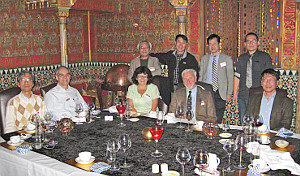
Rhinefield House offers one of the best cuisine in the New Forest and a good wine list. The participants were able to enjoy the dinner in the convivial surrounding of the Alhambra room. At the end of the dinner Carlos thanked all the delegates for having participated in BEM35 and gave them as a souvenir a ceramic bowl, expressly commissioned by WIT from a well know local potter.
Closing of the Conference
The conference offered the participants numerous occasions to interact during coffee breaks, lunch, some excursions, as well as the conference banquet. The meeting was characterised by its friendliness and the number of discussions that took place during the conference sessions as well as outside the lecture rooms.
The conference was closed by Carlos who thanked all the delegates for having come to the New Forest, home of the Campus of Wessex Institute. He hoped that they will continue collaborating with WIT in the future.
Conference Proceedings
The proceedings of BEM/MRM 2013 - Boundary Elements and Other Mesh Reduction Methods XXXV, 450pp (Print ISBN: 978-1-84564-724-7; eISBN: 978-1-84564-725-4) are available from WIT Press. Orders can be placed on the WIT Press web site at www.witpress.com or by email: This email address is being protected from spambots. You need JavaScript enabled to view it., telephone: +44 (0) 238 029 3223 or fax: +44 (0) 238 029 2853.
Papers from the conference will also be hosted online at the WIT eLibrary as Volume 54 of WIT Transactions on Modelling and Simulation (ISSN: 1746-4064, Digital ISSN 1743-355X). For more details visit the WIT eLibrary at http://library.witpress.com

 Wessex Institute
Wessex Institute